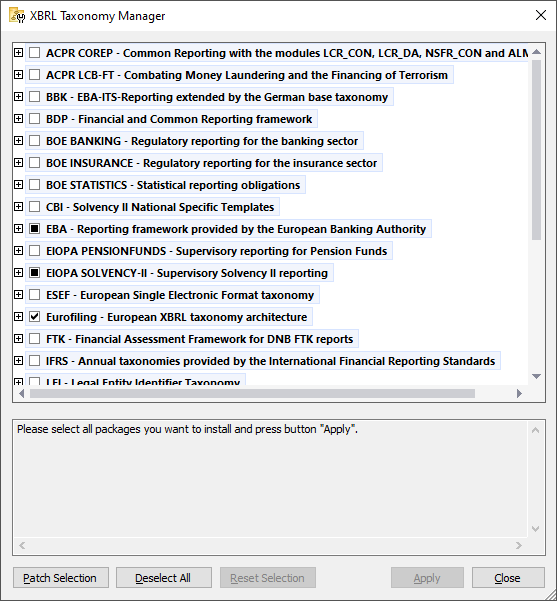XBRL Taxonomy Manager
XBRL Taxonomy Manager is a tool that provides a centralized way to install and manage XBRL taxonomies for use across all Altova XBRL-enabled applications, including StyleVision Server. On Windows, XBRL Taxonomy Manager has a graphical user interface and is also available at the command line. On Linux and Mac*, the tool is available at the command line only.
* The Linux and macOS operating systems are applicable only if you are running XBRL Taxonomy Manager on those operating systems in conjunction with Altova cross-platform server applications such as MapForce Server, StyleVision Server, or RaptorXML+XBRL Server. |
XBRL Taxonomy Manager provides the following features:
•View XBRL taxonomies installed on your computer, and check whether new versions are available for download.
•Download newer versions of XBRL taxonomies independently of the Altova product release cycle. All taxonomies are maintained by Altova on an online-based storage accessible to XBRL Taxonomy Manager, and you can download them as soon as they become available.
•Install or uninstall any of the multiple versions of a given taxonomy (or all versions if necessary).
•A single XBRL taxonomy represents a "package" but it may have dependencies on other taxonomies. Whenever you choose to install or uninstall a particular taxonomy, any dependent taxonomies are detected and also installed or removed automatically. The graphical user interface (or the command line if applicable) informs you when dependencies are being added or removed.
•XBRL taxonomies maintained through XBRL Taxonomy Manager benefit from the XML catalog mechanism that enables URI references in instance or schema documents to be resolved from local files, as opposed to being retrieved from the Internet. This is extremely important in the case of big XBRL taxonomies where schema resolution from remote URIs is not practical or even recommended, mainly for performance reasons.
XBRL Taxonomy Manager provides a way to administer any of the XBRL taxonomies required for use in any one of the Altova XBRL-enabled applications (see list below). These include the European Banking Authority Reporting Framework taxonomies, US-GAAP Financial Reporting taxonomies, and various other country- or domain- specific XBRL taxonomies. To view the full list, either run XBRL Taxonomy Manager or run the list command at the command line.
Custom XBRL Taxonomies
If you need to work with custom XBRL taxonomies that are not included with XBRL Taxonomy Manager, you can enable those as follows:
•From your Altova XBRL-enabled desktop application, run the Tools | Options menu command, and then go to the XBRL | Taxonomy Packages settings page. From the settings page, browse for the .zip package of your custom XBRL taxonomy.
•From your Altova XBRL-enabled server application, provide the --taxonomy-package or --taxonomy-package-config-file options when running commands or API methods that support them. For example, these options are supported by XBRL validation commands such as valxbrl or valxbrltaxonomy in RaptorXML+XBRL Server, or by the run command (or the equivalent API method) in MapForce Server.
Altova XBRL-enabled applications
The following Altova applications are XBRL-enabled and thus benefit from the features provided by XBRL Taxonomy Manager:
•Altova XBRL Add-ins for Excel (EBA, Solvency II)
•MapForce Enterprise Edition
•MapForce Server
•MapForce Server Advanced Edition
•RaptorXML+XBRL Server
•StyleVision Server
•StyleVision Enterprise Edition
•XMLSpy Enterprise Edition
Changes in XBRL taxonomies using XBRL Taxonomy Manager take effect for all the applications listed above if they are installed on the same computer. |
Installation
XBRL Taxonomy Manager is installed automatically whenever you install any Altova XBRL-enabled application or the Altova Mission Kit Enterprise Edition. Likewise, it is removed automatically when you uninstall the last Altova XBRL-enabled application from your computer or the Altova Mission Kit Enterprise Edition.
How it works
Altova maintains an online taxonomy storage where all XBRL taxonomies used in Altova products are stored. This taxonomy storage is updated on a periodical basis, for example, shortly after new versions of relevant taxonomies are released by their issuing organizations.
Whenever you run XBRL Taxonomy Manager at the graphical user interface, information about the latest available taxonomies is displayed in a dialog box, where you can view, install, upgrade or uninstall them. You can also perform the same actions at the command line interface.

You may also install taxonomies by running .altova_taxonomies files downloaded from the Altova website (https://www.altova.com/taxonomy-manager). In addition, when you take an action that requires loading XBRL taxonomies, StyleVision Server prompts you to install the missing XBRL taxonomies.
Regardless of the manner in which taxonomies were installed, all information about installed taxonomies is tracked in a centralized location on your computer, also known as the local cache directory. The local cache directory contains information about Altova packages (except for the actual taxonomy files, which are installed on demand). The local cache directory is at the following path:
Linux | /var/opt/Altova/pkgs |
macOS | /var/Altova/pkgs |
Windows | C:\ProgramData\Altova\pkgs |
The local cache directory gets updated automatically from time to time, so as to propagate the latest state of the online storage to the local computer. More specifically, the cache is updated as follows:
•When you run the XBRL Taxonomy Manager.
•When you run StyleVision Server for the first time in the same calendar day.
•If StyleVision Server is already running, the cache directory gets updated every 24 hours.
•You can also update the local cache from the online storage on demand, by running the update command at the command line interface.
As you install or uninstall taxonomies, the local cache directory gets automatically updated with information about the available and installed taxonomies, as well as the taxonomy files themselves.
The local cache directory is maintained automatically based on the taxonomies you install or uninstall; it should not be altered or deleted manually. If you ever need to reset XBRL Taxonomy Manager to the original "pristine" state, run the reset command of the command line interface, and then run the initialize command. (Alternatively, run the reset command with the -i option.) |